Finance for Managers Report
VerifiedAdded on 2020/02/05
|22
|7874
|190
Report
AI Summary
This report on 'Finance for Managers' covers essential topics such as the importance of financial records, techniques for recording financial information, the evaluation of financial statements for stakeholders, and methods of project appraisal. It discusses the differences between management and financial accounting, the budgetary control process, and various methods of obtaining finance for business projects. The report concludes with a comprehensive analysis of the significance of effective financial management in organizations.
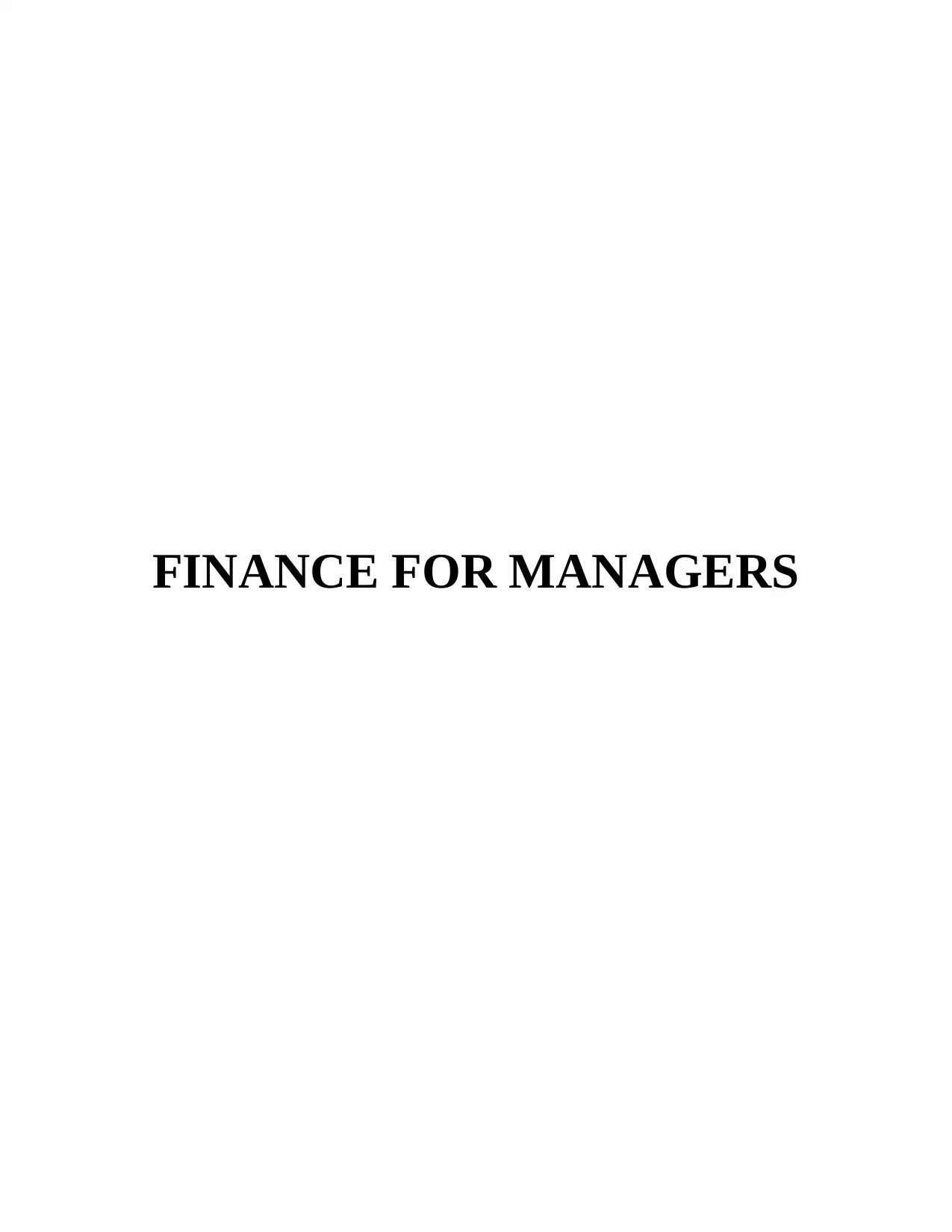
FINANCE FOR MANAGERS
Paraphrase This Document
Need a fresh take? Get an instant paraphrase of this document with our AI Paraphraser
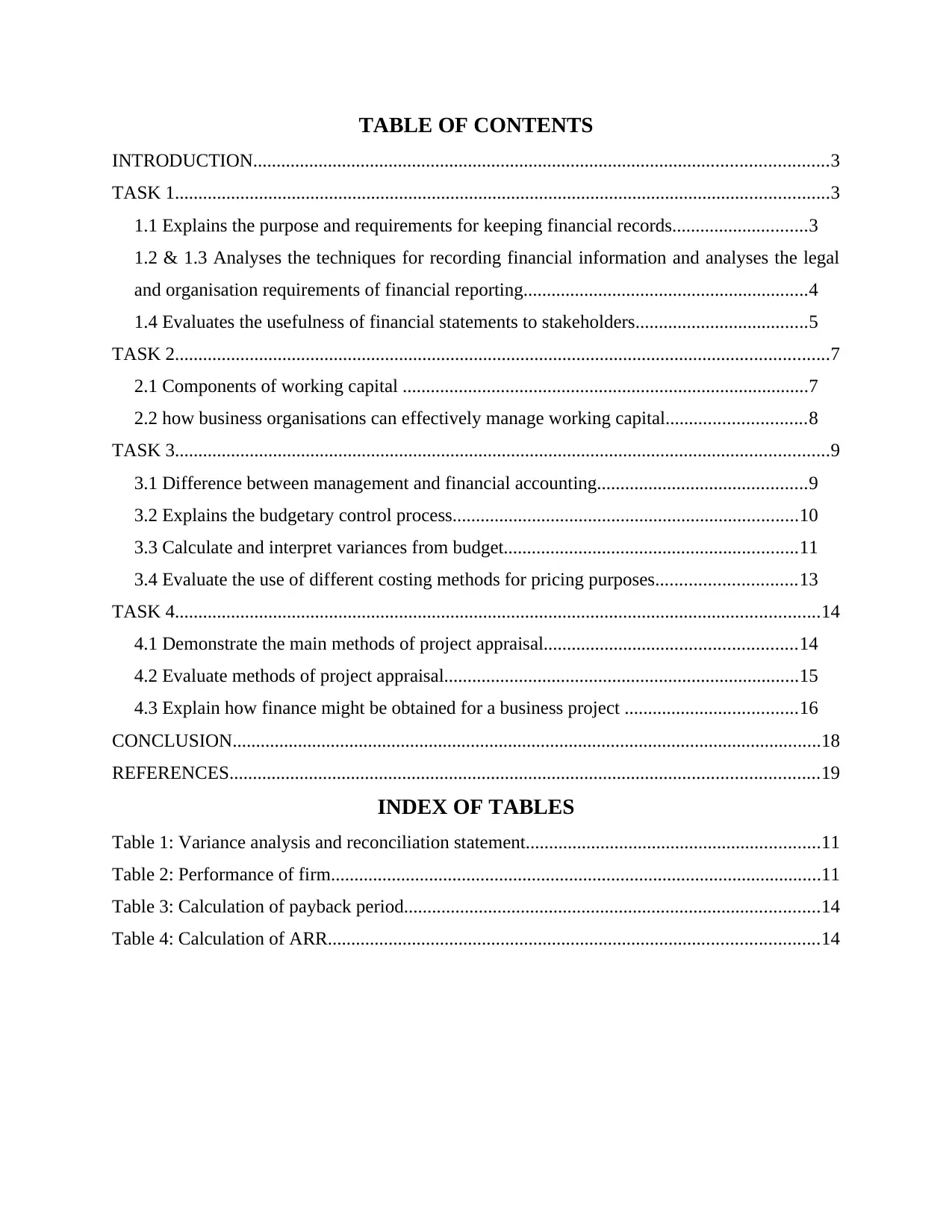
TABLE OF CONTENTS
INTRODUCTION...........................................................................................................................3
TASK 1............................................................................................................................................3
1.1 Explains the purpose and requirements for keeping financial records.............................3
1.2 & 1.3 Analyses the techniques for recording financial information and analyses the legal
and organisation requirements of financial reporting.............................................................4
1.4 Evaluates the usefulness of financial statements to stakeholders.....................................5
TASK 2............................................................................................................................................7
2.1 Components of working capital .......................................................................................7
2.2 how business organisations can effectively manage working capital..............................8
TASK 3............................................................................................................................................9
3.1 Difference between management and financial accounting.............................................9
3.2 Explains the budgetary control process..........................................................................10
3.3 Calculate and interpret variances from budget...............................................................11
3.4 Evaluate the use of different costing methods for pricing purposes..............................13
TASK 4..........................................................................................................................................14
4.1 Demonstrate the main methods of project appraisal......................................................14
4.2 Evaluate methods of project appraisal............................................................................15
4.3 Explain how finance might be obtained for a business project .....................................16
CONCLUSION..............................................................................................................................18
REFERENCES..............................................................................................................................19
INDEX OF TABLES
Table 1: Variance analysis and reconciliation statement...............................................................11
Table 2: Performance of firm.........................................................................................................11
Table 3: Calculation of payback period.........................................................................................14
Table 4: Calculation of ARR.........................................................................................................14
INTRODUCTION...........................................................................................................................3
TASK 1............................................................................................................................................3
1.1 Explains the purpose and requirements for keeping financial records.............................3
1.2 & 1.3 Analyses the techniques for recording financial information and analyses the legal
and organisation requirements of financial reporting.............................................................4
1.4 Evaluates the usefulness of financial statements to stakeholders.....................................5
TASK 2............................................................................................................................................7
2.1 Components of working capital .......................................................................................7
2.2 how business organisations can effectively manage working capital..............................8
TASK 3............................................................................................................................................9
3.1 Difference between management and financial accounting.............................................9
3.2 Explains the budgetary control process..........................................................................10
3.3 Calculate and interpret variances from budget...............................................................11
3.4 Evaluate the use of different costing methods for pricing purposes..............................13
TASK 4..........................................................................................................................................14
4.1 Demonstrate the main methods of project appraisal......................................................14
4.2 Evaluate methods of project appraisal............................................................................15
4.3 Explain how finance might be obtained for a business project .....................................16
CONCLUSION..............................................................................................................................18
REFERENCES..............................................................................................................................19
INDEX OF TABLES
Table 1: Variance analysis and reconciliation statement...............................................................11
Table 2: Performance of firm.........................................................................................................11
Table 3: Calculation of payback period.........................................................................................14
Table 4: Calculation of ARR.........................................................................................................14
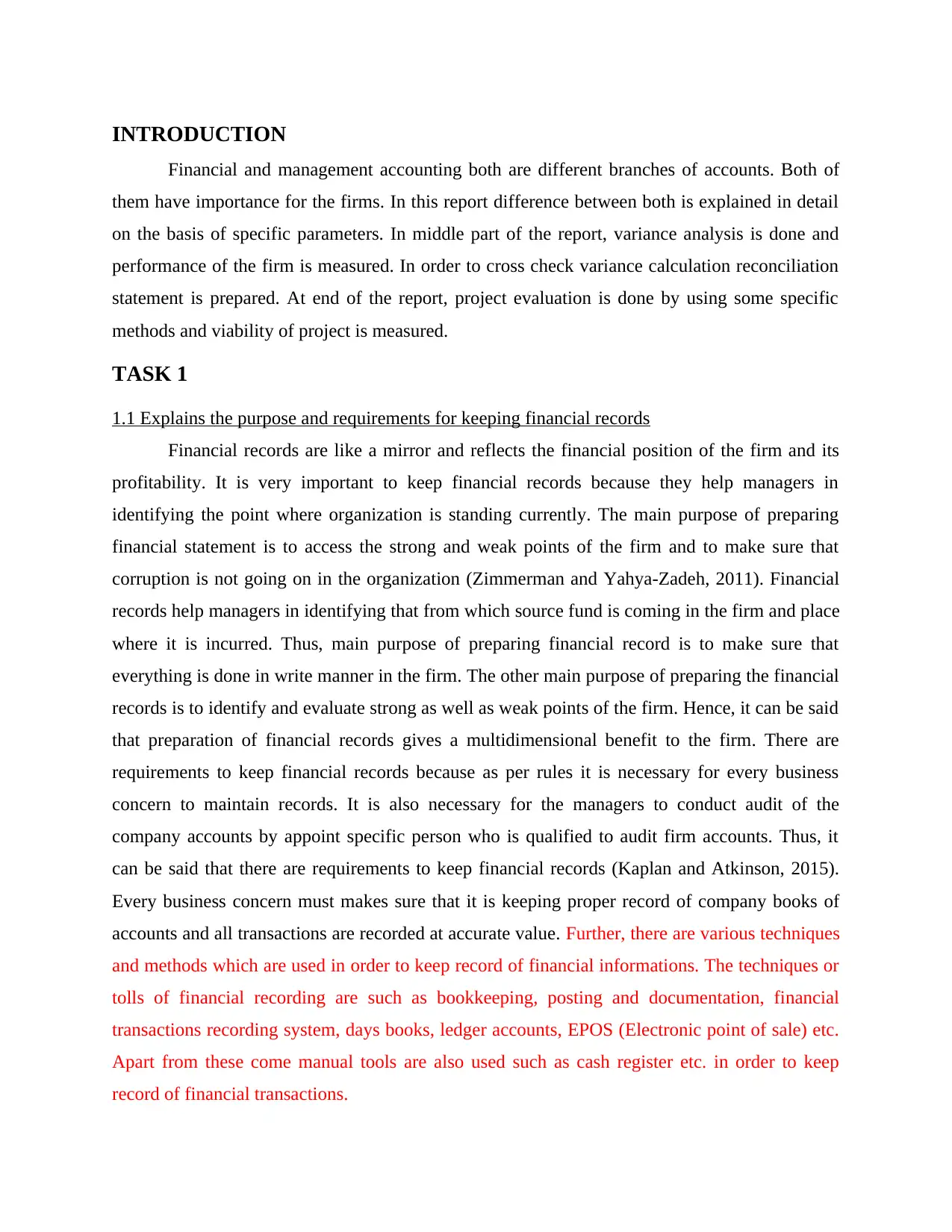
INTRODUCTION
Financial and management accounting both are different branches of accounts. Both of
them have importance for the firms. In this report difference between both is explained in detail
on the basis of specific parameters. In middle part of the report, variance analysis is done and
performance of the firm is measured. In order to cross check variance calculation reconciliation
statement is prepared. At end of the report, project evaluation is done by using some specific
methods and viability of project is measured.
TASK 1
1.1 Explains the purpose and requirements for keeping financial records
Financial records are like a mirror and reflects the financial position of the firm and its
profitability. It is very important to keep financial records because they help managers in
identifying the point where organization is standing currently. The main purpose of preparing
financial statement is to access the strong and weak points of the firm and to make sure that
corruption is not going on in the organization (Zimmerman and Yahya-Zadeh, 2011). Financial
records help managers in identifying that from which source fund is coming in the firm and place
where it is incurred. Thus, main purpose of preparing financial record is to make sure that
everything is done in write manner in the firm. The other main purpose of preparing the financial
records is to identify and evaluate strong as well as weak points of the firm. Hence, it can be said
that preparation of financial records gives a multidimensional benefit to the firm. There are
requirements to keep financial records because as per rules it is necessary for every business
concern to maintain records. It is also necessary for the managers to conduct audit of the
company accounts by appoint specific person who is qualified to audit firm accounts. Thus, it
can be said that there are requirements to keep financial records (Kaplan and Atkinson, 2015).
Every business concern must makes sure that it is keeping proper record of company books of
accounts and all transactions are recorded at accurate value. Further, there are various techniques
and methods which are used in order to keep record of financial informations. The techniques or
tolls of financial recording are such as bookkeeping, posting and documentation, financial
transactions recording system, days books, ledger accounts, EPOS (Electronic point of sale) etc.
Apart from these come manual tools are also used such as cash register etc. in order to keep
record of financial transactions.
Financial and management accounting both are different branches of accounts. Both of
them have importance for the firms. In this report difference between both is explained in detail
on the basis of specific parameters. In middle part of the report, variance analysis is done and
performance of the firm is measured. In order to cross check variance calculation reconciliation
statement is prepared. At end of the report, project evaluation is done by using some specific
methods and viability of project is measured.
TASK 1
1.1 Explains the purpose and requirements for keeping financial records
Financial records are like a mirror and reflects the financial position of the firm and its
profitability. It is very important to keep financial records because they help managers in
identifying the point where organization is standing currently. The main purpose of preparing
financial statement is to access the strong and weak points of the firm and to make sure that
corruption is not going on in the organization (Zimmerman and Yahya-Zadeh, 2011). Financial
records help managers in identifying that from which source fund is coming in the firm and place
where it is incurred. Thus, main purpose of preparing financial record is to make sure that
everything is done in write manner in the firm. The other main purpose of preparing the financial
records is to identify and evaluate strong as well as weak points of the firm. Hence, it can be said
that preparation of financial records gives a multidimensional benefit to the firm. There are
requirements to keep financial records because as per rules it is necessary for every business
concern to maintain records. It is also necessary for the managers to conduct audit of the
company accounts by appoint specific person who is qualified to audit firm accounts. Thus, it
can be said that there are requirements to keep financial records (Kaplan and Atkinson, 2015).
Every business concern must makes sure that it is keeping proper record of company books of
accounts and all transactions are recorded at accurate value. Further, there are various techniques
and methods which are used in order to keep record of financial informations. The techniques or
tolls of financial recording are such as bookkeeping, posting and documentation, financial
transactions recording system, days books, ledger accounts, EPOS (Electronic point of sale) etc.
Apart from these come manual tools are also used such as cash register etc. in order to keep
record of financial transactions.
⊘ This is a preview!⊘
Do you want full access?
Subscribe today to unlock all pages.

Trusted by 1+ million students worldwide
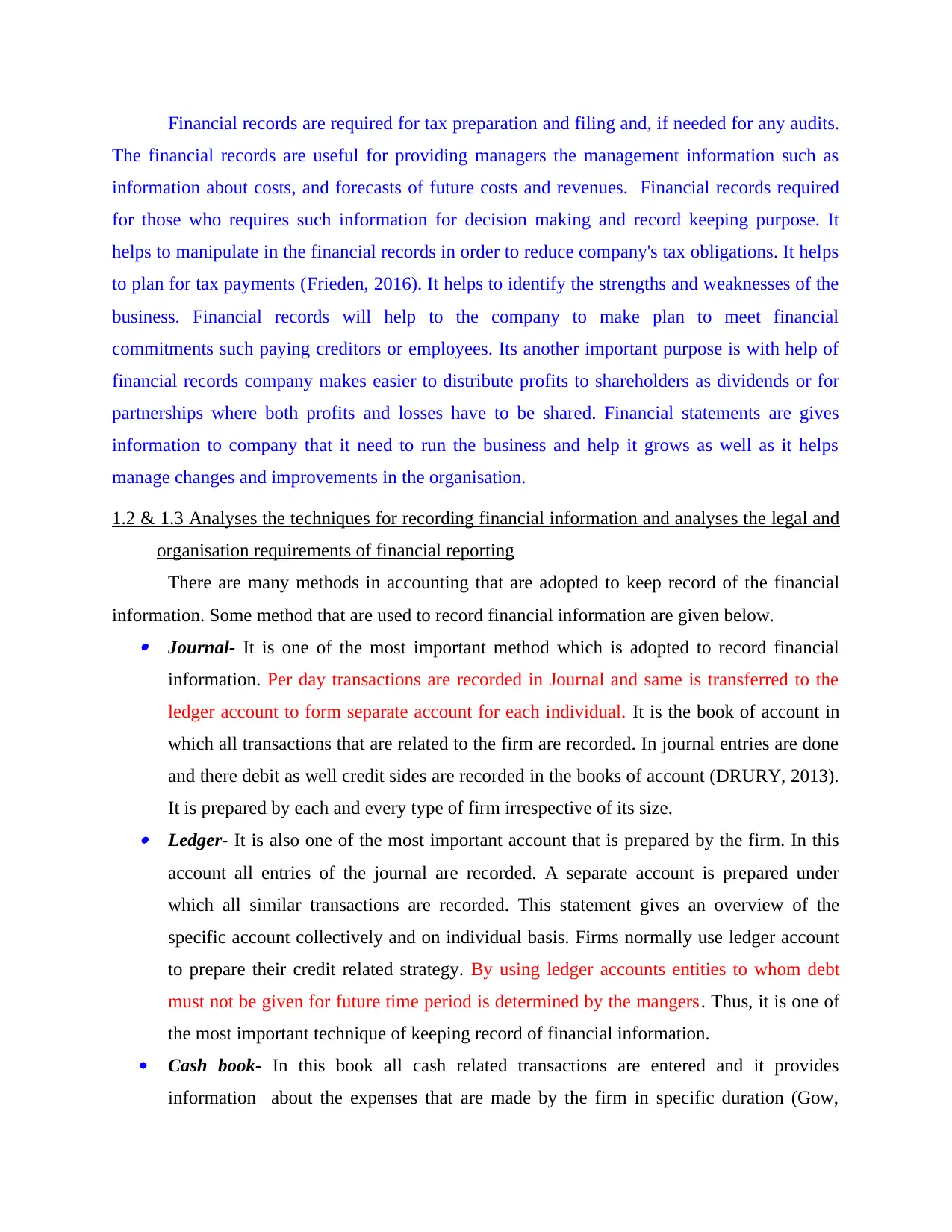
Financial records are required for tax preparation and filing and, if needed for any audits.
The financial records are useful for providing managers the management information such as
information about costs, and forecasts of future costs and revenues. Financial records required
for those who requires such information for decision making and record keeping purpose. It
helps to manipulate in the financial records in order to reduce company's tax obligations. It helps
to plan for tax payments (Frieden, 2016). It helps to identify the strengths and weaknesses of the
business. Financial records will help to the company to make plan to meet financial
commitments such paying creditors or employees. Its another important purpose is with help of
financial records company makes easier to distribute profits to shareholders as dividends or for
partnerships where both profits and losses have to be shared. Financial statements are gives
information to company that it need to run the business and help it grows as well as it helps
manage changes and improvements in the organisation.
1.2 & 1.3 Analyses the techniques for recording financial information and analyses the legal and
organisation requirements of financial reporting
There are many methods in accounting that are adopted to keep record of the financial
information. Some method that are used to record financial information are given below. Journal- It is one of the most important method which is adopted to record financial
information. Per day transactions are recorded in Journal and same is transferred to the
ledger account to form separate account for each individual. It is the book of account in
which all transactions that are related to the firm are recorded. In journal entries are done
and there debit as well credit sides are recorded in the books of account (DRURY, 2013).
It is prepared by each and every type of firm irrespective of its size. Ledger- It is also one of the most important account that is prepared by the firm. In this
account all entries of the journal are recorded. A separate account is prepared under
which all similar transactions are recorded. This statement gives an overview of the
specific account collectively and on individual basis. Firms normally use ledger account
to prepare their credit related strategy. By using ledger accounts entities to whom debt
must not be given for future time period is determined by the mangers. Thus, it is one of
the most important technique of keeping record of financial information.
Cash book- In this book all cash related transactions are entered and it provides
information about the expenses that are made by the firm in specific duration (Gow,
The financial records are useful for providing managers the management information such as
information about costs, and forecasts of future costs and revenues. Financial records required
for those who requires such information for decision making and record keeping purpose. It
helps to manipulate in the financial records in order to reduce company's tax obligations. It helps
to plan for tax payments (Frieden, 2016). It helps to identify the strengths and weaknesses of the
business. Financial records will help to the company to make plan to meet financial
commitments such paying creditors or employees. Its another important purpose is with help of
financial records company makes easier to distribute profits to shareholders as dividends or for
partnerships where both profits and losses have to be shared. Financial statements are gives
information to company that it need to run the business and help it grows as well as it helps
manage changes and improvements in the organisation.
1.2 & 1.3 Analyses the techniques for recording financial information and analyses the legal and
organisation requirements of financial reporting
There are many methods in accounting that are adopted to keep record of the financial
information. Some method that are used to record financial information are given below. Journal- It is one of the most important method which is adopted to record financial
information. Per day transactions are recorded in Journal and same is transferred to the
ledger account to form separate account for each individual. It is the book of account in
which all transactions that are related to the firm are recorded. In journal entries are done
and there debit as well credit sides are recorded in the books of account (DRURY, 2013).
It is prepared by each and every type of firm irrespective of its size. Ledger- It is also one of the most important account that is prepared by the firm. In this
account all entries of the journal are recorded. A separate account is prepared under
which all similar transactions are recorded. This statement gives an overview of the
specific account collectively and on individual basis. Firms normally use ledger account
to prepare their credit related strategy. By using ledger accounts entities to whom debt
must not be given for future time period is determined by the mangers. Thus, it is one of
the most important technique of keeping record of financial information.
Cash book- In this book all cash related transactions are entered and it provides
information about the expenses that are made by the firm in specific duration (Gow,
Paraphrase This Document
Need a fresh take? Get an instant paraphrase of this document with our AI Paraphraser
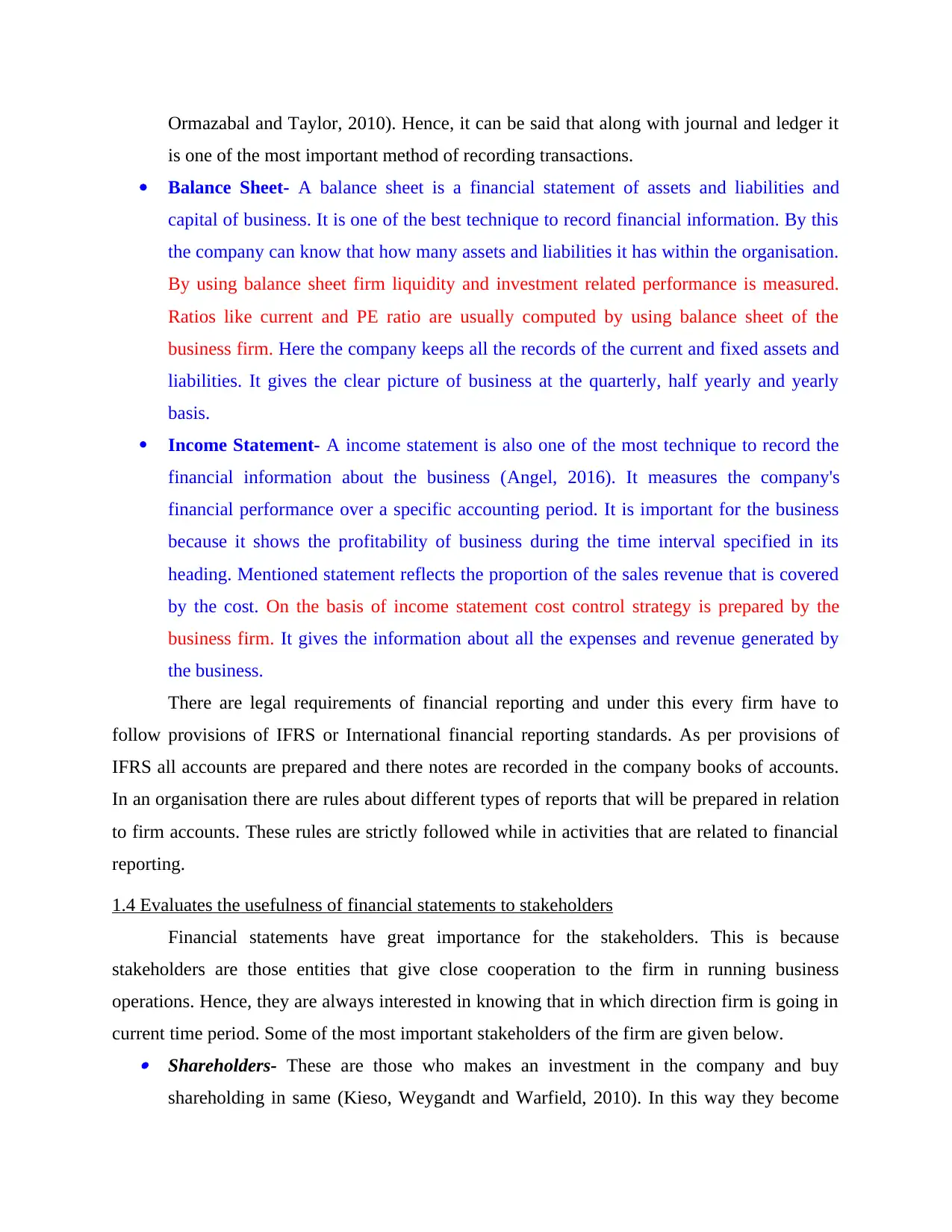
Ormazabal and Taylor, 2010). Hence, it can be said that along with journal and ledger it
is one of the most important method of recording transactions.
Balance Sheet- A balance sheet is a financial statement of assets and liabilities and
capital of business. It is one of the best technique to record financial information. By this
the company can know that how many assets and liabilities it has within the organisation.
By using balance sheet firm liquidity and investment related performance is measured.
Ratios like current and PE ratio are usually computed by using balance sheet of the
business firm. Here the company keeps all the records of the current and fixed assets and
liabilities. It gives the clear picture of business at the quarterly, half yearly and yearly
basis.
Income Statement- A income statement is also one of the most technique to record the
financial information about the business (Angel, 2016). It measures the company's
financial performance over a specific accounting period. It is important for the business
because it shows the profitability of business during the time interval specified in its
heading. Mentioned statement reflects the proportion of the sales revenue that is covered
by the cost. On the basis of income statement cost control strategy is prepared by the
business firm. It gives the information about all the expenses and revenue generated by
the business.
There are legal requirements of financial reporting and under this every firm have to
follow provisions of IFRS or International financial reporting standards. As per provisions of
IFRS all accounts are prepared and there notes are recorded in the company books of accounts.
In an organisation there are rules about different types of reports that will be prepared in relation
to firm accounts. These rules are strictly followed while in activities that are related to financial
reporting.
1.4 Evaluates the usefulness of financial statements to stakeholders
Financial statements have great importance for the stakeholders. This is because
stakeholders are those entities that give close cooperation to the firm in running business
operations. Hence, they are always interested in knowing that in which direction firm is going in
current time period. Some of the most important stakeholders of the firm are given below. Shareholders- These are those who makes an investment in the company and buy
shareholding in same (Kieso, Weygandt and Warfield, 2010). In this way they become
is one of the most important method of recording transactions.
Balance Sheet- A balance sheet is a financial statement of assets and liabilities and
capital of business. It is one of the best technique to record financial information. By this
the company can know that how many assets and liabilities it has within the organisation.
By using balance sheet firm liquidity and investment related performance is measured.
Ratios like current and PE ratio are usually computed by using balance sheet of the
business firm. Here the company keeps all the records of the current and fixed assets and
liabilities. It gives the clear picture of business at the quarterly, half yearly and yearly
basis.
Income Statement- A income statement is also one of the most technique to record the
financial information about the business (Angel, 2016). It measures the company's
financial performance over a specific accounting period. It is important for the business
because it shows the profitability of business during the time interval specified in its
heading. Mentioned statement reflects the proportion of the sales revenue that is covered
by the cost. On the basis of income statement cost control strategy is prepared by the
business firm. It gives the information about all the expenses and revenue generated by
the business.
There are legal requirements of financial reporting and under this every firm have to
follow provisions of IFRS or International financial reporting standards. As per provisions of
IFRS all accounts are prepared and there notes are recorded in the company books of accounts.
In an organisation there are rules about different types of reports that will be prepared in relation
to firm accounts. These rules are strictly followed while in activities that are related to financial
reporting.
1.4 Evaluates the usefulness of financial statements to stakeholders
Financial statements have great importance for the stakeholders. This is because
stakeholders are those entities that give close cooperation to the firm in running business
operations. Hence, they are always interested in knowing that in which direction firm is going in
current time period. Some of the most important stakeholders of the firm are given below. Shareholders- These are those who makes an investment in the company and buy
shareholding in same (Kieso, Weygandt and Warfield, 2010). In this way they become
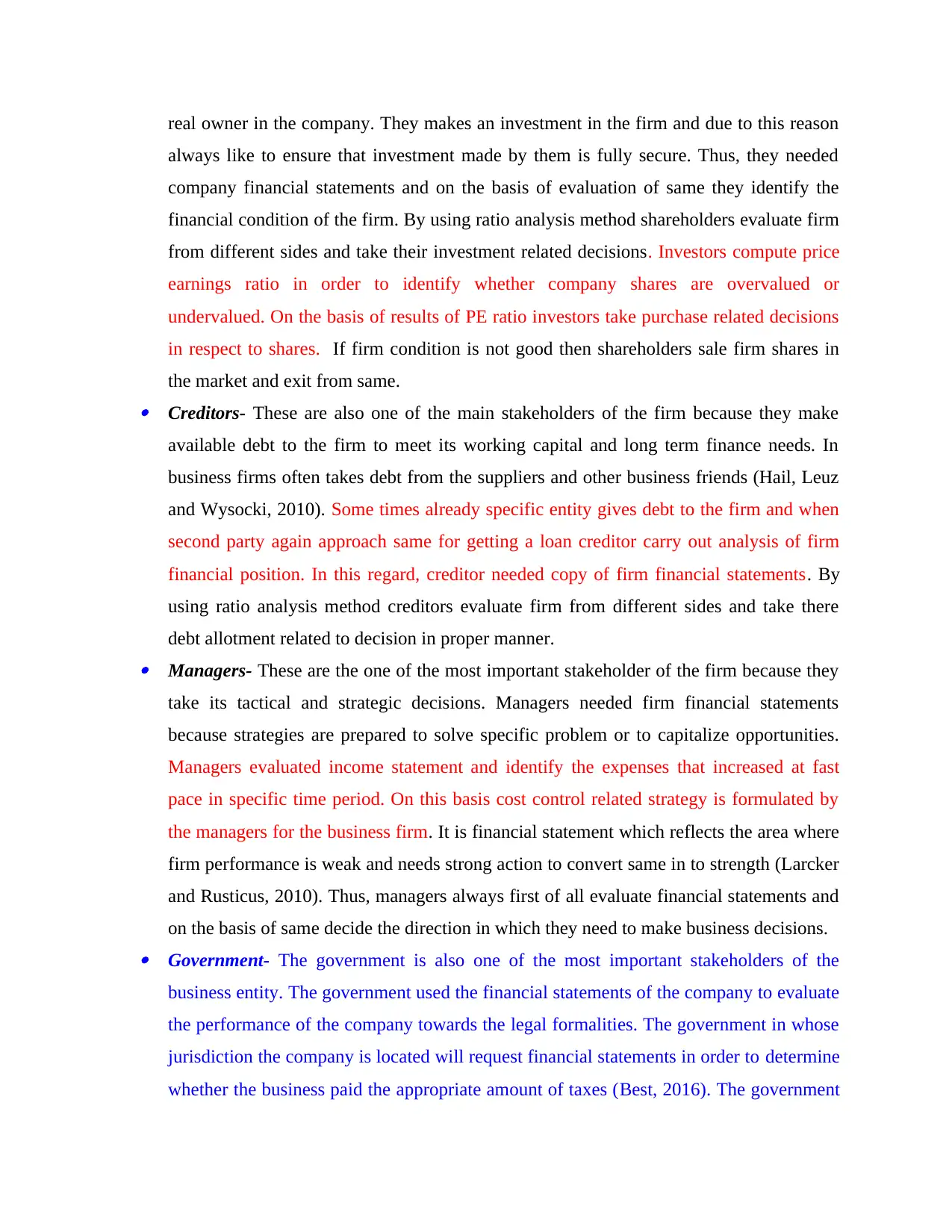
real owner in the company. They makes an investment in the firm and due to this reason
always like to ensure that investment made by them is fully secure. Thus, they needed
company financial statements and on the basis of evaluation of same they identify the
financial condition of the firm. By using ratio analysis method shareholders evaluate firm
from different sides and take their investment related decisions. Investors compute price
earnings ratio in order to identify whether company shares are overvalued or
undervalued. On the basis of results of PE ratio investors take purchase related decisions
in respect to shares. If firm condition is not good then shareholders sale firm shares in
the market and exit from same. Creditors- These are also one of the main stakeholders of the firm because they make
available debt to the firm to meet its working capital and long term finance needs. In
business firms often takes debt from the suppliers and other business friends (Hail, Leuz
and Wysocki, 2010). Some times already specific entity gives debt to the firm and when
second party again approach same for getting a loan creditor carry out analysis of firm
financial position. In this regard, creditor needed copy of firm financial statements. By
using ratio analysis method creditors evaluate firm from different sides and take there
debt allotment related to decision in proper manner. Managers- These are the one of the most important stakeholder of the firm because they
take its tactical and strategic decisions. Managers needed firm financial statements
because strategies are prepared to solve specific problem or to capitalize opportunities.
Managers evaluated income statement and identify the expenses that increased at fast
pace in specific time period. On this basis cost control related strategy is formulated by
the managers for the business firm. It is financial statement which reflects the area where
firm performance is weak and needs strong action to convert same in to strength (Larcker
and Rusticus, 2010). Thus, managers always first of all evaluate financial statements and
on the basis of same decide the direction in which they need to make business decisions. Government- The government is also one of the most important stakeholders of the
business entity. The government used the financial statements of the company to evaluate
the performance of the company towards the legal formalities. The government in whose
jurisdiction the company is located will request financial statements in order to determine
whether the business paid the appropriate amount of taxes (Best, 2016). The government
always like to ensure that investment made by them is fully secure. Thus, they needed
company financial statements and on the basis of evaluation of same they identify the
financial condition of the firm. By using ratio analysis method shareholders evaluate firm
from different sides and take their investment related decisions. Investors compute price
earnings ratio in order to identify whether company shares are overvalued or
undervalued. On the basis of results of PE ratio investors take purchase related decisions
in respect to shares. If firm condition is not good then shareholders sale firm shares in
the market and exit from same. Creditors- These are also one of the main stakeholders of the firm because they make
available debt to the firm to meet its working capital and long term finance needs. In
business firms often takes debt from the suppliers and other business friends (Hail, Leuz
and Wysocki, 2010). Some times already specific entity gives debt to the firm and when
second party again approach same for getting a loan creditor carry out analysis of firm
financial position. In this regard, creditor needed copy of firm financial statements. By
using ratio analysis method creditors evaluate firm from different sides and take there
debt allotment related to decision in proper manner. Managers- These are the one of the most important stakeholder of the firm because they
take its tactical and strategic decisions. Managers needed firm financial statements
because strategies are prepared to solve specific problem or to capitalize opportunities.
Managers evaluated income statement and identify the expenses that increased at fast
pace in specific time period. On this basis cost control related strategy is formulated by
the managers for the business firm. It is financial statement which reflects the area where
firm performance is weak and needs strong action to convert same in to strength (Larcker
and Rusticus, 2010). Thus, managers always first of all evaluate financial statements and
on the basis of same decide the direction in which they need to make business decisions. Government- The government is also one of the most important stakeholders of the
business entity. The government used the financial statements of the company to evaluate
the performance of the company towards the legal formalities. The government in whose
jurisdiction the company is located will request financial statements in order to determine
whether the business paid the appropriate amount of taxes (Best, 2016). The government
⊘ This is a preview!⊘
Do you want full access?
Subscribe today to unlock all pages.

Trusted by 1+ million students worldwide
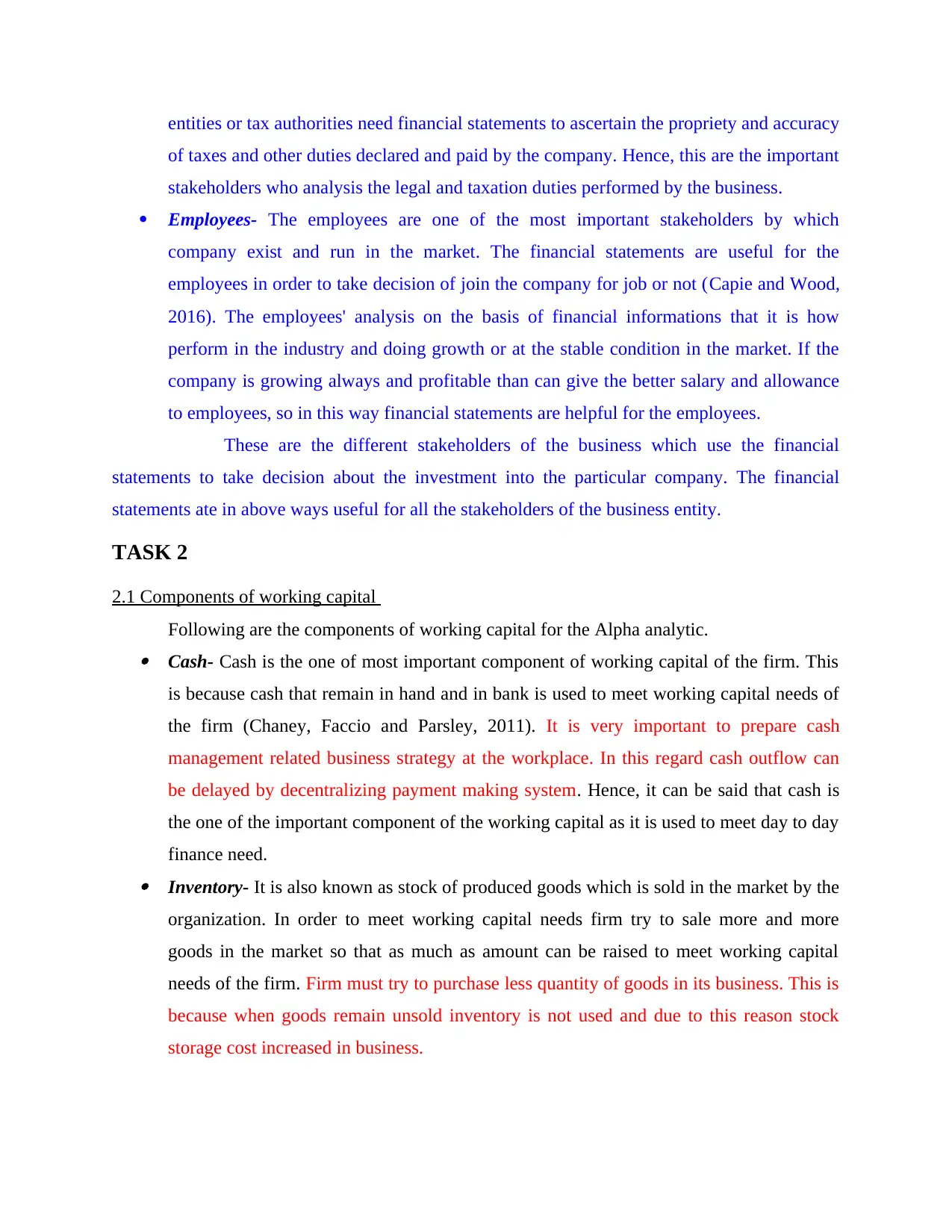
entities or tax authorities need financial statements to ascertain the propriety and accuracy
of taxes and other duties declared and paid by the company. Hence, this are the important
stakeholders who analysis the legal and taxation duties performed by the business.
Employees- The employees are one of the most important stakeholders by which
company exist and run in the market. The financial statements are useful for the
employees in order to take decision of join the company for job or not (Capie and Wood,
2016). The employees' analysis on the basis of financial informations that it is how
perform in the industry and doing growth or at the stable condition in the market. If the
company is growing always and profitable than can give the better salary and allowance
to employees, so in this way financial statements are helpful for the employees.
These are the different stakeholders of the business which use the financial
statements to take decision about the investment into the particular company. The financial
statements ate in above ways useful for all the stakeholders of the business entity.
TASK 2
2.1 Components of working capital
Following are the components of working capital for the Alpha analytic. Cash- Cash is the one of most important component of working capital of the firm. This
is because cash that remain in hand and in bank is used to meet working capital needs of
the firm (Chaney, Faccio and Parsley, 2011). It is very important to prepare cash
management related business strategy at the workplace. In this regard cash outflow can
be delayed by decentralizing payment making system. Hence, it can be said that cash is
the one of the important component of the working capital as it is used to meet day to day
finance need. Inventory- It is also known as stock of produced goods which is sold in the market by the
organization. In order to meet working capital needs firm try to sale more and more
goods in the market so that as much as amount can be raised to meet working capital
needs of the firm. Firm must try to purchase less quantity of goods in its business. This is
because when goods remain unsold inventory is not used and due to this reason stock
storage cost increased in business.
of taxes and other duties declared and paid by the company. Hence, this are the important
stakeholders who analysis the legal and taxation duties performed by the business.
Employees- The employees are one of the most important stakeholders by which
company exist and run in the market. The financial statements are useful for the
employees in order to take decision of join the company for job or not (Capie and Wood,
2016). The employees' analysis on the basis of financial informations that it is how
perform in the industry and doing growth or at the stable condition in the market. If the
company is growing always and profitable than can give the better salary and allowance
to employees, so in this way financial statements are helpful for the employees.
These are the different stakeholders of the business which use the financial
statements to take decision about the investment into the particular company. The financial
statements ate in above ways useful for all the stakeholders of the business entity.
TASK 2
2.1 Components of working capital
Following are the components of working capital for the Alpha analytic. Cash- Cash is the one of most important component of working capital of the firm. This
is because cash that remain in hand and in bank is used to meet working capital needs of
the firm (Chaney, Faccio and Parsley, 2011). It is very important to prepare cash
management related business strategy at the workplace. In this regard cash outflow can
be delayed by decentralizing payment making system. Hence, it can be said that cash is
the one of the important component of the working capital as it is used to meet day to day
finance need. Inventory- It is also known as stock of produced goods which is sold in the market by the
organization. In order to meet working capital needs firm try to sale more and more
goods in the market so that as much as amount can be raised to meet working capital
needs of the firm. Firm must try to purchase less quantity of goods in its business. This is
because when goods remain unsold inventory is not used and due to this reason stock
storage cost increased in business.
Paraphrase This Document
Need a fresh take? Get an instant paraphrase of this document with our AI Paraphraser
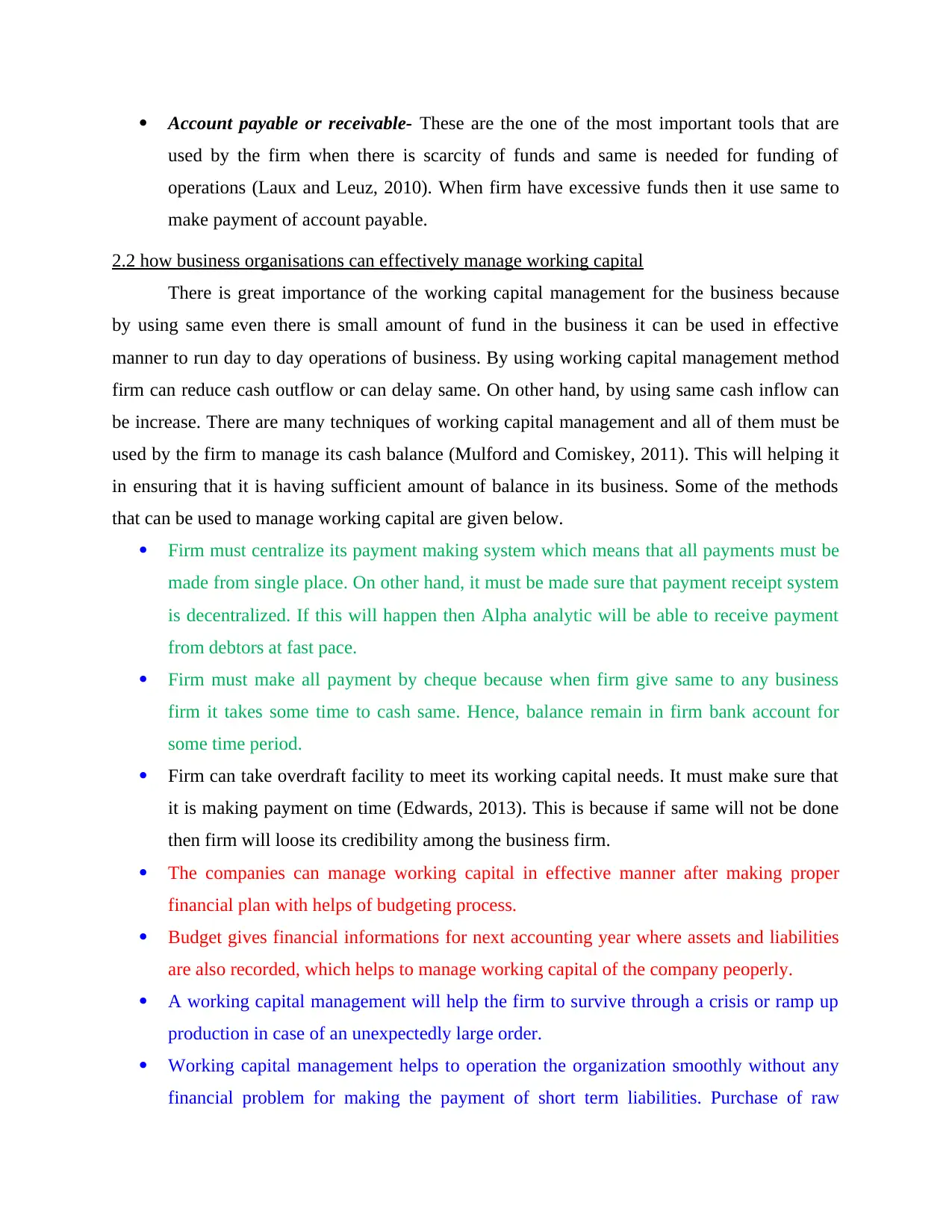
Account payable or receivable- These are the one of the most important tools that are
used by the firm when there is scarcity of funds and same is needed for funding of
operations (Laux and Leuz, 2010). When firm have excessive funds then it use same to
make payment of account payable.
2.2 how business organisations can effectively manage working capital
There is great importance of the working capital management for the business because
by using same even there is small amount of fund in the business it can be used in effective
manner to run day to day operations of business. By using working capital management method
firm can reduce cash outflow or can delay same. On other hand, by using same cash inflow can
be increase. There are many techniques of working capital management and all of them must be
used by the firm to manage its cash balance (Mulford and Comiskey, 2011). This will helping it
in ensuring that it is having sufficient amount of balance in its business. Some of the methods
that can be used to manage working capital are given below.
Firm must centralize its payment making system which means that all payments must be
made from single place. On other hand, it must be made sure that payment receipt system
is decentralized. If this will happen then Alpha analytic will be able to receive payment
from debtors at fast pace.
Firm must make all payment by cheque because when firm give same to any business
firm it takes some time to cash same. Hence, balance remain in firm bank account for
some time period.
Firm can take overdraft facility to meet its working capital needs. It must make sure that
it is making payment on time (Edwards, 2013). This is because if same will not be done
then firm will loose its credibility among the business firm.
The companies can manage working capital in effective manner after making proper
financial plan with helps of budgeting process.
Budget gives financial informations for next accounting year where assets and liabilities
are also recorded, which helps to manage working capital of the company peoperly.
A working capital management will help the firm to survive through a crisis or ramp up
production in case of an unexpectedly large order.
Working capital management helps to operation the organization smoothly without any
financial problem for making the payment of short term liabilities. Purchase of raw
used by the firm when there is scarcity of funds and same is needed for funding of
operations (Laux and Leuz, 2010). When firm have excessive funds then it use same to
make payment of account payable.
2.2 how business organisations can effectively manage working capital
There is great importance of the working capital management for the business because
by using same even there is small amount of fund in the business it can be used in effective
manner to run day to day operations of business. By using working capital management method
firm can reduce cash outflow or can delay same. On other hand, by using same cash inflow can
be increase. There are many techniques of working capital management and all of them must be
used by the firm to manage its cash balance (Mulford and Comiskey, 2011). This will helping it
in ensuring that it is having sufficient amount of balance in its business. Some of the methods
that can be used to manage working capital are given below.
Firm must centralize its payment making system which means that all payments must be
made from single place. On other hand, it must be made sure that payment receipt system
is decentralized. If this will happen then Alpha analytic will be able to receive payment
from debtors at fast pace.
Firm must make all payment by cheque because when firm give same to any business
firm it takes some time to cash same. Hence, balance remain in firm bank account for
some time period.
Firm can take overdraft facility to meet its working capital needs. It must make sure that
it is making payment on time (Edwards, 2013). This is because if same will not be done
then firm will loose its credibility among the business firm.
The companies can manage working capital in effective manner after making proper
financial plan with helps of budgeting process.
Budget gives financial informations for next accounting year where assets and liabilities
are also recorded, which helps to manage working capital of the company peoperly.
A working capital management will help the firm to survive through a crisis or ramp up
production in case of an unexpectedly large order.
Working capital management helps to operation the organization smoothly without any
financial problem for making the payment of short term liabilities. Purchase of raw
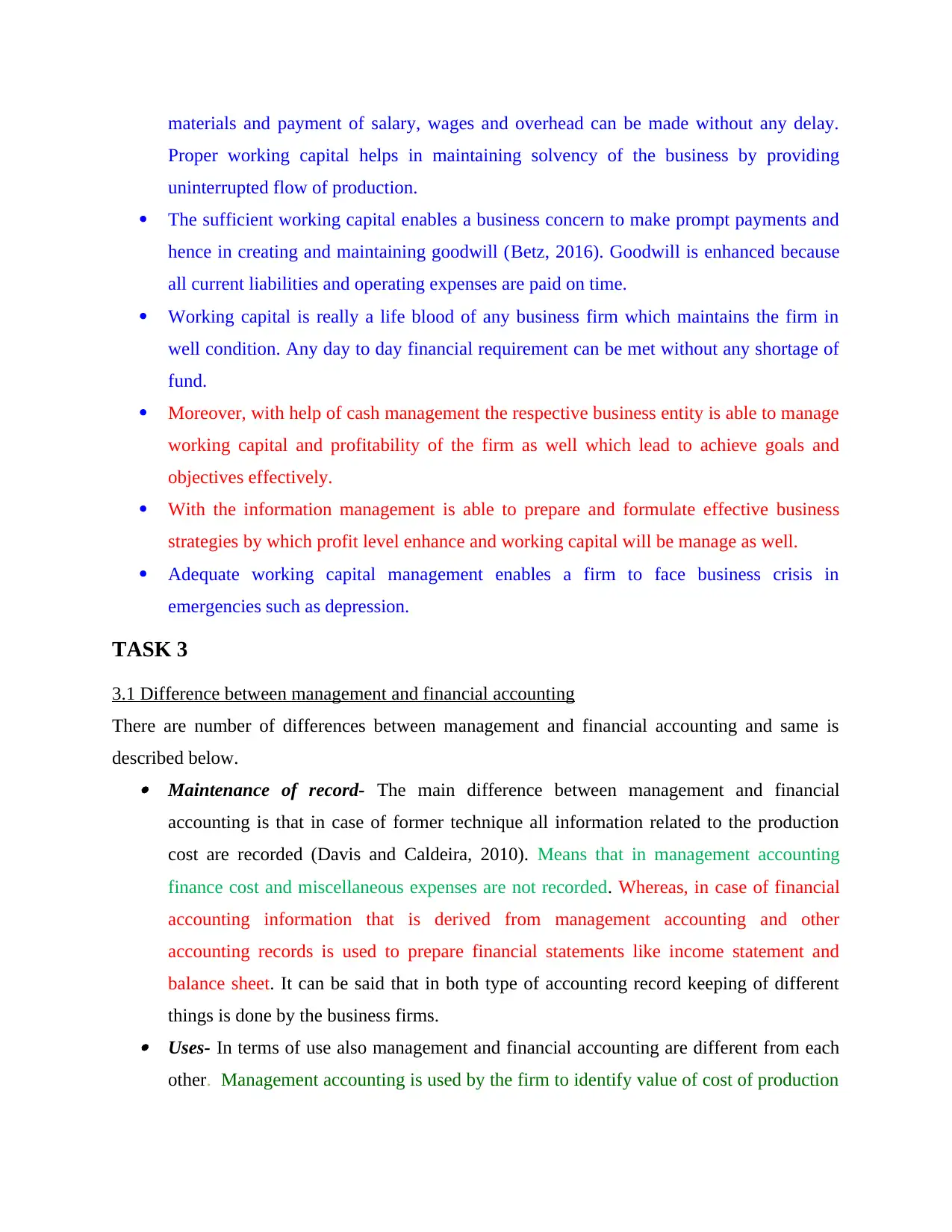
materials and payment of salary, wages and overhead can be made without any delay.
Proper working capital helps in maintaining solvency of the business by providing
uninterrupted flow of production.
The sufficient working capital enables a business concern to make prompt payments and
hence in creating and maintaining goodwill (Betz, 2016). Goodwill is enhanced because
all current liabilities and operating expenses are paid on time.
Working capital is really a life blood of any business firm which maintains the firm in
well condition. Any day to day financial requirement can be met without any shortage of
fund.
Moreover, with help of cash management the respective business entity is able to manage
working capital and profitability of the firm as well which lead to achieve goals and
objectives effectively.
With the information management is able to prepare and formulate effective business
strategies by which profit level enhance and working capital will be manage as well.
Adequate working capital management enables a firm to face business crisis in
emergencies such as depression.
TASK 3
3.1 Difference between management and financial accounting
There are number of differences between management and financial accounting and same is
described below. Maintenance of record- The main difference between management and financial
accounting is that in case of former technique all information related to the production
cost are recorded (Davis and Caldeira, 2010). Means that in management accounting
finance cost and miscellaneous expenses are not recorded. Whereas, in case of financial
accounting information that is derived from management accounting and other
accounting records is used to prepare financial statements like income statement and
balance sheet. It can be said that in both type of accounting record keeping of different
things is done by the business firms. Uses- In terms of use also management and financial accounting are different from each
other. Management accounting is used by the firm to identify value of cost of production
Proper working capital helps in maintaining solvency of the business by providing
uninterrupted flow of production.
The sufficient working capital enables a business concern to make prompt payments and
hence in creating and maintaining goodwill (Betz, 2016). Goodwill is enhanced because
all current liabilities and operating expenses are paid on time.
Working capital is really a life blood of any business firm which maintains the firm in
well condition. Any day to day financial requirement can be met without any shortage of
fund.
Moreover, with help of cash management the respective business entity is able to manage
working capital and profitability of the firm as well which lead to achieve goals and
objectives effectively.
With the information management is able to prepare and formulate effective business
strategies by which profit level enhance and working capital will be manage as well.
Adequate working capital management enables a firm to face business crisis in
emergencies such as depression.
TASK 3
3.1 Difference between management and financial accounting
There are number of differences between management and financial accounting and same is
described below. Maintenance of record- The main difference between management and financial
accounting is that in case of former technique all information related to the production
cost are recorded (Davis and Caldeira, 2010). Means that in management accounting
finance cost and miscellaneous expenses are not recorded. Whereas, in case of financial
accounting information that is derived from management accounting and other
accounting records is used to prepare financial statements like income statement and
balance sheet. It can be said that in both type of accounting record keeping of different
things is done by the business firms. Uses- In terms of use also management and financial accounting are different from each
other. Management accounting is used by the firm to identify value of cost of production
⊘ This is a preview!⊘
Do you want full access?
Subscribe today to unlock all pages.

Trusted by 1+ million students worldwide

(Bebbington, Unerman and O'Dwyer, 2014). Apart from this its methods are used to
identify whether all expenses are made within determined limit. It can be said that
management accounting is a tool which help in measuring the effectiveness of the
management. There is different use of the financial accounting and it is the tool which
indicate the financial condition and profitability of the firm. By using the financial
accounting techniques profitability of the firm is measured and its strong as well as weak
points are also identified by the business firm. Hence, it can be said that there are
different uses of the financial and management accounting.
Users- There are internal users of the company information that is pertained to the
management accounting (Flamholtz, 2012). Contrary to this, in case of financial
accounting there are both internal and external users. It can be said that there is wide use
of financial accounting then management accounting.
3.2 Explains the budgetary control process
Budgetary control process is the one of the most important technique of management
accounting which is used by the most of the firms. Budget control process of the firm is given
below. Forecast- It is one of the most important step of the budget and under this first of all
forecast of future time period is made and accordingly values of components of the
budget is determined (Denison, 2010). In order to make forecast of figures business
environment is analysed and advanced techniques like simulation is used by the firms. By
using simulation method on the basis of estimation of probability of happening of
likelihood of event is estimated and prediction is made about the increase or decrease that
can be observed in the cash flows of business firm for budgeted time period. In this very
first step company predict that what objective has to achieve from the budget. On the
basis of forecast budget statement is prepared. Determining values of the budget- After preparation of forecast and considering lots of
factors values are determined for the budget. These values acts as standards against which
performance of the firm is compared in order to identify the level of performance given
by same in its business. Here the company is determining with help of forecast that how
many values will be of the budget which preparing.
identify whether all expenses are made within determined limit. It can be said that
management accounting is a tool which help in measuring the effectiveness of the
management. There is different use of the financial accounting and it is the tool which
indicate the financial condition and profitability of the firm. By using the financial
accounting techniques profitability of the firm is measured and its strong as well as weak
points are also identified by the business firm. Hence, it can be said that there are
different uses of the financial and management accounting.
Users- There are internal users of the company information that is pertained to the
management accounting (Flamholtz, 2012). Contrary to this, in case of financial
accounting there are both internal and external users. It can be said that there is wide use
of financial accounting then management accounting.
3.2 Explains the budgetary control process
Budgetary control process is the one of the most important technique of management
accounting which is used by the most of the firms. Budget control process of the firm is given
below. Forecast- It is one of the most important step of the budget and under this first of all
forecast of future time period is made and accordingly values of components of the
budget is determined (Denison, 2010). In order to make forecast of figures business
environment is analysed and advanced techniques like simulation is used by the firms. By
using simulation method on the basis of estimation of probability of happening of
likelihood of event is estimated and prediction is made about the increase or decrease that
can be observed in the cash flows of business firm for budgeted time period. In this very
first step company predict that what objective has to achieve from the budget. On the
basis of forecast budget statement is prepared. Determining values of the budget- After preparation of forecast and considering lots of
factors values are determined for the budget. These values acts as standards against which
performance of the firm is compared in order to identify the level of performance given
by same in its business. Here the company is determining with help of forecast that how
many values will be of the budget which preparing.
Paraphrase This Document
Need a fresh take? Get an instant paraphrase of this document with our AI Paraphraser

Recoding of actual figures- After passage of the specific time period facts and figures
related to the budget components are recorded in the statement (Garrison and et.al.,
2010). Same is used in further stages to access performance of the firm. The company is
in the third step of budgetary control process recode the actual figures with the
determining and forecasting values of the budget in the business. By this the managers
able to know actual performance of the business in the industry and compare from past
performance as well. Comparison of actual with budgeted figures- It is one of the most important step and
under this actual figures are compared with the budgeted figure. On this basis it is
identified whether firm give excellent or poor performance in its business. In this step the
company is compare the actual budget with the budgeted figure and analysis that is it
profitable for the company or not. With the help of this step company take the decision to
implement budget in business or not. Process of comparison among the actual outputs
and expected data, known as a variance analysis. With this the manager can derive
performance of the firm and able to take corrective actions for upcoming financial years. Recommendation from middle level managers- In case of negative variance middle level
managers are asked to give recommendations to the top management regarding poor
performance. These recommendations are given after considering number of factors. In
this step the middle level managers recommend about the budget that whether it should
implement or not. If the budget is negative than should not implement and if it is in
favourable situation than company will adopt the budget in the business.
Corrective actions- Top managers receive recommendations and wherever require make
changes in same to draft corrective actions (Lennox, Francis and Wang, 2011). These are
implemented at ground level of the firm to control occurrence of negative variance. This
is the last and final step of the budgetary control process, in this company take the
decision to implement or not on the basis of above steps. Here the manager analyse and
evaluate overall process that whether it is implementing and giving output in proper
manner or not, if not then take corrective actions.
These are the above steps by which the budget can be prepare and control in the
business in an effective manner. It gives the proper decision to take the corrective action about
the budgeted project.
related to the budget components are recorded in the statement (Garrison and et.al.,
2010). Same is used in further stages to access performance of the firm. The company is
in the third step of budgetary control process recode the actual figures with the
determining and forecasting values of the budget in the business. By this the managers
able to know actual performance of the business in the industry and compare from past
performance as well. Comparison of actual with budgeted figures- It is one of the most important step and
under this actual figures are compared with the budgeted figure. On this basis it is
identified whether firm give excellent or poor performance in its business. In this step the
company is compare the actual budget with the budgeted figure and analysis that is it
profitable for the company or not. With the help of this step company take the decision to
implement budget in business or not. Process of comparison among the actual outputs
and expected data, known as a variance analysis. With this the manager can derive
performance of the firm and able to take corrective actions for upcoming financial years. Recommendation from middle level managers- In case of negative variance middle level
managers are asked to give recommendations to the top management regarding poor
performance. These recommendations are given after considering number of factors. In
this step the middle level managers recommend about the budget that whether it should
implement or not. If the budget is negative than should not implement and if it is in
favourable situation than company will adopt the budget in the business.
Corrective actions- Top managers receive recommendations and wherever require make
changes in same to draft corrective actions (Lennox, Francis and Wang, 2011). These are
implemented at ground level of the firm to control occurrence of negative variance. This
is the last and final step of the budgetary control process, in this company take the
decision to implement or not on the basis of above steps. Here the manager analyse and
evaluate overall process that whether it is implementing and giving output in proper
manner or not, if not then take corrective actions.
These are the above steps by which the budget can be prepare and control in the
business in an effective manner. It gives the proper decision to take the corrective action about
the budgeted project.

3.3 Calculate and interpret variances from budget
Table 1: Variance analysis and reconciliation statement
Actual Budget
Sales 69900 62000 -7900
Direct labor 24200 22512 -1688
Direct material 23260 19796 -3464
Fixed overheads 6000 6000 0
Operating profit 16440 13693
-
2747.37258
78278
Table 2: Performance of firm
Actual Budget
Sales 69900 62000
Favour
able
Direct labor 24200 22512
Unfavo
utable
Direct material 23260 19796
Unfavo
utable
Fixed overheads 6000 6000
Unfavo
utable
Operating profit 16440 13693
Unfavo
utable
Interpretation Sales variance- It is a variance which reflect the deviation in sales that comes from the
budgeted value. It can be seen that Alpha analytic make more sales then budgeted value
and on this basis it can be said that firm give good performance in its business. But due to
elevation in sales cost also get increased which is not good for the business. However,
variance will be assumed favorable for the business. High demand for the product in the
market may be one of the main reason due to which variance comes in existence
(Agoglia, Doupnik and Tsakumis, 2011). In order to prevent material from eroding firm
Table 1: Variance analysis and reconciliation statement
Actual Budget
Sales 69900 62000 -7900
Direct labor 24200 22512 -1688
Direct material 23260 19796 -3464
Fixed overheads 6000 6000 0
Operating profit 16440 13693
-
2747.37258
78278
Table 2: Performance of firm
Actual Budget
Sales 69900 62000
Favour
able
Direct labor 24200 22512
Unfavo
utable
Direct material 23260 19796
Unfavo
utable
Fixed overheads 6000 6000
Unfavo
utable
Operating profit 16440 13693
Unfavo
utable
Interpretation Sales variance- It is a variance which reflect the deviation in sales that comes from the
budgeted value. It can be seen that Alpha analytic make more sales then budgeted value
and on this basis it can be said that firm give good performance in its business. But due to
elevation in sales cost also get increased which is not good for the business. However,
variance will be assumed favorable for the business. High demand for the product in the
market may be one of the main reason due to which variance comes in existence
(Agoglia, Doupnik and Tsakumis, 2011). In order to prevent material from eroding firm
⊘ This is a preview!⊘
Do you want full access?
Subscribe today to unlock all pages.

Trusted by 1+ million students worldwide
1 out of 22
Related Documents
Your All-in-One AI-Powered Toolkit for Academic Success.
+13062052269
info@desklib.com
Available 24*7 on WhatsApp / Email
![[object Object]](/_next/static/media/star-bottom.7253800d.svg)
Unlock your academic potential
Copyright © 2020–2025 A2Z Services. All Rights Reserved. Developed and managed by ZUCOL.




